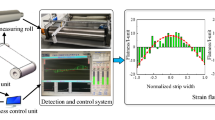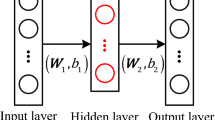Abstract
A high-accuracy flatness prediction model is the basis for realizing flatness control. Real flatness is typically reflected as the strain distribution, which is a vector. However, it is difficult to obtain ideal results if the real flatness is directly used as the output value of the flatness intelligent prediction model. Thus, it is necessary to seek an abstract representation method of real flatness. For this reason, two new intelligent flatness representation models were proposed based on the autoencoder of unsupervised learning theory: the flatness autoencoder representation (FAR) model and the flatness stacked sparse autoencoder representation (FSSAR) model. Compared with the traditional Legendre fourth-order polynomial representation model, the representation accuracies of the FAR and FSSAR models are significantly improved, better representing the flatness defects, like the double tight edge. The optimal number of bottleneck layer neurons in the FAR and FSSAR models is 5, which means that five basic patterns can accurately represent real flatness. Compared with the FAR model, the FSSAR model has higher representation accuracy, although the flatness basic pattern is more abstract, and the physical meaning is not clear enough. Furthermore, the accuracy of the FAR model is slightly lower than that of the FSSAR model. However, it can automatically learn the flatness basic pattern with a very clear physical meaning for both the theoretical and real flatness, which is an optimal intelligent representation method for flatness.


















Similar content being viewed by others
References
J. Sun, P.F. Shan, Z. Wei, Y.H. Hu, Q.L. Wang, W. Peng, D.H. Zhang, J. Iron Steel Res. Int. 28 (2021) 563–573. https://doi.org/10.1007/s42243-020-00505-x.
D. Xu, Q. Yang, X.C. Wang, H.N. He, Y.Z. Sun, W.P. Li, Micromachines 11 (2020) 916. https://doi.org/10.3390/mi11100916.
D.C. Wang, H.M. Liu, J. Liu, Chin J. Mech. Eng. 30 (2017) 1248–1261. https://doi.org/10.1007/s10033-017-0163-8.
M. Ataka, ISIJ Int. 55 (2015) 89–102. https://doi.org/10.2355/isijinternational.55.89.
J.D. Li, X.C. Wang, Q. Yang, J.W. Zhao, Z.D. Wu, Z.H. Wang, Int. J. Adv. Manuf. Technol. 123 (2022) 389–405. https://doi.org/10.1007/s00170-022-10196-1.
Q.L. Wang, J. Sun, X. Li, Y.M. Liu, P.F. Wang, D.H. Zhang, J. Manuf. Process 34 (2018) 637–649. https://doi.org/10.1016/j.jmapro.2018.07.008.
Y. Peng, H.M. Liu, D.C. Wang, J. Cent. South Univ. Technol. 14 (2007) 278–284. https://doi.org/10.1007/s11771-007-0055-7.
Y. Zhang, Q. Yang, X.C. Wang, J. Iron Steel Res. Int. 18 (2011) 27–32. https://doi.org/10.1016/S1006-706X(12)60030-2.
X.Y. Shan, H.M. Liu, C.Y. Jia, J.L. Sun, J. Iron Steel Res. Int. 19 (2012) 31–37. https://doi.org/10.1016/S1006-706X(12)60070-3.
D.C. Wang, H.M. Liu, J. Iron Steel Res. Int. 19 (2012) 22–27. https://doi.org/10.1016/S1006-706X(12)60055-7.
D.C. Wang, W. Zhang, Z.J. Wang, H.M. Liu, Iron and Steel 51 (2016) No. 9, 51–56. https://doi.org/10.13228/j.boyuan.issn0449-749x.20160017.
C. Cui, G. Cao, X. Li, Z. Gao, X. Zhou, Z. Liu, J. Mater. Process. Technol. 309 (2022) 117736. https://doi.org/10.1016/j.jmatprotec.2022.117736.
Y. Liu, Z.Y. Gao, X.M. Zhou, Q.D. Zhang, J. Mech. Eng. 56 (2020) No. 11, 121–131. https://doi.org/10.3901/JME.2020.11.121.
S.H. Zhang, L. Deng, L.Z. Che, J. Manuf. Process. 75 (2022) 100–109. https://doi.org/10.1016/j.jmapro.2021.12.063.
D.C. Wang, Y.H. Xu, T.Y. Zhang, X.B. Ma, H.M. Liu, Metall. Res. Technol. 118 (2021) 303. https://doi.org/10.1051/metal/2020090.
H. Choi, Y. Kim, H. Lee, IEEE Trans. Ind. Inform. 17 (2021) 3890–3900. https://doi.org/10.1109/TII.2020.3015003.
Jagadish, D.L. Soni, S. Barad, Trans. Indian Inst. Met. 73 (2020) 1535–1542. https://doi.org/10.1007/s12666-020-01928-6.
I. Mohanty, R. Banerjee, A. Santara, S. Kundu, P. Mitra, Ironmak. Steelmak. 48 (2021) 953–961. https://doi.org/10.1080/03019233.2020.1848303.
Y.H. Xu, D.C. Wang, Y.M. Wang, W.Y. Yuan, H.X. Yu, H.M. Liu, Iron and Steel 56 (2021) No. 9, 26–35. https://doi.org/10.13228/j.boyuan.issn0449-749x.20210259.
M. Soleimani, S. Toofan, J. Circuits Syst. Comput. 28 (2019) 1950097. https://doi.org/10.1142/S021812661950097X.
H.M. Liu, X.Y. Shan, C.Y. Jia, J. Iron Steel Res. Int. 20 (2013) No. 8, 1–7. https://doi.org/10.1016/S1006-706X(13)60133-8.
M.M. Song, H.M. Liu, D.C. Wang, Y.H. Xu, ISIJ Int. 60 (2020) 286–296. https://doi.org/10.2355/isijinternational.ISIJINT-2019-328.
P.F. Wang, H.F. Wang, X. Li, D.H. Zhang, W.T. Li, Y.L. Yao, Appl. Math. Model. 91 (2021) 863–874. https://doi.org/10.1016/j.apm.2020.09.028.
X.G. Li, Y.M. Fang, L. Liu, J. Braz. Soc. Mech. Sci. Eng. 42 (2020) 270. https://doi.org/10.1007/s40430-020-02357-8.
X.L. Zhang, W.Y. Gao, Y.J. Lai, Y.T. Cheng, J. Cent. South Univ. 24 (2017) 2222–2230. https://doi.org/10.1007/s11771-017-3631-5.
C.Y. Jia, X.Y. Shan, Y.C. Cui, T. Bai, F.J. Cui, J. Iron Steel Res. Int. 20 (2013) No. 10, 17–22. https://doi.org/10.1016/S1006-706X(13)60170-3.
H.X. Yu, D.C. Wang, H.M. Liu, T.Y. Zhang, L.P. Yang, ISIJ Int. 60 (2020) 939–947. https://doi.org/10.2355/isijinternational.ISIJINT-2019-472.
Y. LeCun, Y. Bengio, G. Hinton, Nature 521 (2015) 436–444. https://doi.org/10.1038/nature14539.
J. Pereira, T. Schwede, Science 374 (2021) 1319–1320. https://doi.org/10.1126/science.abm8295.
S. Dargan, M. Kumar, M.R. Ayyagari, G. Kumar, Arch. Comput. Method Eng. 27 (2020) 1071–1092. https://doi.org/10.1007/s11831-019-09344-w.
N. Dhengre, S. Sinha, Vis. Comput. 38 (2022) 837–847. https://doi.org/10.1007/s00371-020-02054-6.
J.T. Chien, C.W. Wang, IEEE Trans. Pattern Anal. Mach. Intell. 44 (2022) 4975–4986. https://doi.org/10.1109/TPAMI.2021.3068187.
B. Schölkopf, F. Locatello, S. Bauer, N.R. Ke, N. Kalchbrenner, A. Goyal, Y. Bengio, Proc. IEEE 109 (2021) 612–634. https://doi.org/10.1109/JPROC.2021.3058954.
Acknowledgements
This project is supported by the National Natural Science Foundation of China (No. U21A20118) and the National Key Laboratory of Metal Forming Technology and Heavy Equipment, China National Heavy Machinery Research Institute Co., Ltd. (No. S2208100.W04).
Author information
Authors and Affiliations
Corresponding author
Ethics declarations
Conflict of interest
The authors declare no conflict of interest.
Rights and permissions
Springer Nature or its licensor (e.g. a society or other partner) holds exclusive rights to this article under a publishing agreement with the author(s) or other rightsholder(s); author self-archiving of the accepted manuscript version of this article is solely governed by the terms of such publishing agreement and applicable law.
About this article
Cite this article
Xu, Yh., Wang, Dc., Duan, Bw. et al. Data-driven flatness intelligent representation method of cold rolled strip. J. Iron Steel Res. Int. 30, 994–1012 (2023). https://doi.org/10.1007/s42243-023-00956-y
Received:
Revised:
Accepted:
Published:
Issue Date:
DOI: https://doi.org/10.1007/s42243-023-00956-y




